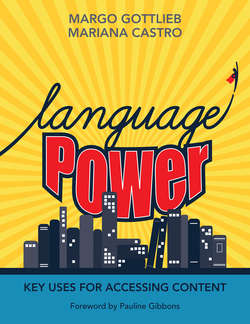Читать книгу Language Power - Margo Gottlieb - Страница 11
На сайте Литреса книга снята с продажи.
Features of the Book
ОглавлениеThere is a full complement of features to lead educators to better understand, reflect, and communicate with others the power of language. Take the DARE is a feature that challenges the reader, teacher teams, or professional learning communities, along with school leaders, to reenvision teaching and learning through a language lens. It encourages these stakeholders to take time to extend their thinking on a particular issue or apply ideas related to DARE to their own settings. Questions are suited for stimulating educators to think about taking next steps for incorporating key uses of academic language into their own work.
Figures are illustrative or extensions of information presented in the text. As teachers and teacher educators ourselves, we are aware of the ongoing search for classroom tools. We hope that these are both stimulating and useful, as we converted many of them into resources.
Resources are educator tools designed for students, classrooms, and schools; they are intended to be stimuli for many stakeholders, including teachers, teacher teams, professional learning communities, and school leaders to ponder, plan, and practice. These charts, graphs, and activity sheets are presented in a chapter with exemplars. They are duplicated as blank forms at the close of each chapter for personal use or to share with other educators, students, and families. They are noted in the manuscript by the icon you see of two persons putting together two puzzle pieces.
Source: BrainPOP®, https://www.brainpop.com
To read a QR code, you must have a smartphone or tablet with a camera. We recommend that you download a QR code reader app that is made specifically for your phone or tablet brand.
The QR codes that are embedded in the pages throughout the book take you directly to the BrainPOP® website where you are able to utilize the cited source. We hope that you take advantage of these free materials, including movies, text, graphic organizers, activities, concept maps, and games. We have used these materials as a jump start for thinking about and illustrating academic language use in classrooms.
The references that relate to the four perspectives are presented at the close of each chapter and include cited references as well as seminal work in the field we suggest for further reading. We feel that the close proximity of references to the topic at hand increases the awareness of the literature base from which we draw and reinforces our ideas. References also serve as resources unto themselves for those of you who wish to probe more deeply into specific content.
